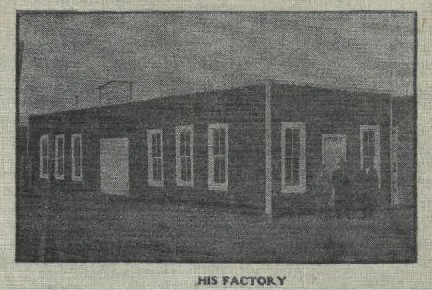Baker Friction Heat & Boiler Company
Introduction
Text-to-speech Audio
Charles S. Lewis Baker was born into slavery in 1859 in Savannah, MO. His mother passed away when he was young and after the Civil War, he was raised by his father Abraham Baker. Abe operated a freight company, making deliveries to St. Joseph and the neighboring areas via wagon, and employed his young sons, Charles and Peter. During one of these delivery trips, the brothers forgot to grease the wagon axle, creating a great amount of friction heat. When a rainstorm rolled in and the drops fell upon the heated wheel, it produced steam, later inspiring Charles’s invention.
After the turn of the century, Charles began patenting his inventions, such as the “electromechanical automatic signaling and collision preventing device” for the railroad in 1902. In 1904, he made national news with the friction heater, the invention inspired by his childhood realization. Utilizing a rotating wooden core within a metal cylinder, Baker believed he could create steam heat for homes and train cars at little to no expense. Gaining investors, he opened the Friction Heat & Boiler Company in St. Joseph that year, its factory located at 611 Francis Street. Charles's brother Peter and daughter Lulu were both stakeholders in the company.
Images

Backstory and Context
Text-to-speech Audio
Charles S. Lewis Baker was born into slavery in 1859 in Savannah, MO. His mother passed away when he was young and after the Civil War, he was raised by his father Abraham Baker. Abe operated a freight company, making deliveries to St. Joseph and the neighboring areas via wagon, and employed his young sons, Charles and Peter. During one of these delivery trips, the brothers forgot to grease the wagon axle, creating a great amount of friction heat. When a rainstorm rolled in and the drops fell upon the heated wheel, it produced steam, later inspiring Charles’s invention.
Charles married Carrie Carriger in 1880 and worked as a mail carrier in St. Joseph. In 1889, his grandmother, Dolly Baker, passed away at the estimated age of 102, inspiring Charles to help develop a home for aging ex-slaves. Raising funds and national support, the Home for Aged and Dependent Ex-Slaves began construction in 1894, but this structure was destroyed by a cyclone two years later. A second home was built at 24th and Mitchell Streets, but was permanently closed in 1899.
After the turn of the century, Charles began patenting his inventions, such as the “electromechanical automatic signaling and collision preventing device” for the railroad in 1902. In 1904, he made national news with the friction heater, the invention inspired by his childhood realization. Utilizing a rotating wooden core within a metal cylinder, Baker believed he could create steam heat for homes and train cars at little to no expense. Gaining investors, he opened the Friction Heat & Boiler Company in St. Joseph that year, its factory located at 611 Francis Street. Charles's brother Peter and daughter Lulu were both stakeholders in the company.
Almost immediately, Charles had to fight for the rights to his own invention. The white investors in the company attempted to declare bankruptcy and sell off Baker’s patent. Baker won the court case against his board and continued to maintain his ownership of the idea throughout his life.
The company expanded, opening the Baker Revolutionizing Superheating Molecule Union Developing Company in Jersey City in 1906 and demonstrating the invention at the 1907 Jamestown Exposition to heat and serve coffee. They also demonstrated its ability to heat a train car between Savannah and St. Joseph in 1906 and it was soon installed to Santa Fe and Rock Island railroads.
Baker spent years marketing his invention to homes and businesses. It was even reported that the Japanese government was interested in utilizing the device. In 1910 Baker opened an office in Detroit and hired Thomas W. Brown to market the invention. What happened to the business and invention are unknown. Charles S.L. Baker returned to St. Joseph when his health began to fail and he passed away at the home of his daughter in 1926. He was buried in the Baker family plot in Savannah, MO.
